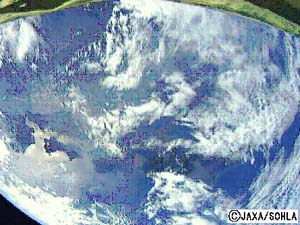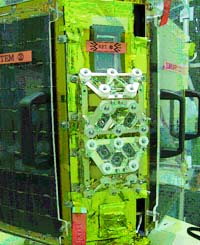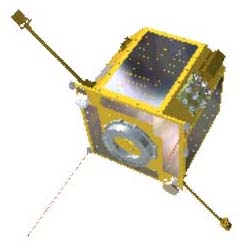Report on current operational status of small satellite "SOHLA-1
By Ms. Haruko Noda, secretariat of Space Oriented Higashiosaka Leading Association of Japan (SOHLA)
SOHLA-1 is normally orbiting in its scheduled circular orbit at a height of around 669 km
The Space Oriented Higashiosaka Leading Association of Japan (SOHLA) confirmed that SOHLA-1 was launched as a piggyback satellite with the Greenhouse Gases Observing Satellite "IBUKI" (GOSAT) by H-IIA Launch Vehicle No. 15 at 12:54 p.m. on January 23, 2009 (Japan Standard Time) from the Tanegashima Space Center. Further, it was confirmed that the satellite was working well at 14:36 according to S-band communication between SOHLA-1 and the Tanegashima Tracking and Communication Center of JAXA.
We are, as a rule, communicating with SOHLA-1 once in the daytime and once at night via one of the three Tracking and Communication Centers of JAXA, which are located in Okinawa, Masuda and Katsuura, And by now we have carried out spin rate control three times and spin axis control (for attitude change) five times in order to confirm the performance of the attitude control system and to improve the generated power.
The satellite is working well and we are now increasing its spin rate and confirming its movements in order to improve the attitude stability.
On February 8, we completed our check of the GPS receiver and monitoring camera at the side of the satellite and we successfully captured images of the Japanese islands.

This picture was captured at noon on February 2.
We could confirm an image had been taken of part of the Japanese islands (Kyushu is shown on the left) although the satellite was spinning at 10 rpm. In addition, we could confirm the boom, shown at the top of the picture, was functional before its deployment. The camera was developed for small satellites in a collaborative effort between JAXA and Shikino Haitekku Corp.
On February 28, we completed our checks on almost all of the mission devices and successfully deployed the antenna for armature communication.
After that we conducted Measurement for Waveforms of VHF Lightning Impulses (BMW) and distinguished an area where lightning was occurring from an area where no lightning was occurring. We also confirmed that we had not received any data for the area where lightning was not occurring and successfully confirmed that we had received a signal from the area where there was lightning.


Signal from lightning over AustraliaLaser reflector at the side of the satellite
We carried out an experiment using the laser reflector while over Japan between February 18 and 23.
We successfully observed a signal of the reflector at Tanegashima station of JAXA, at the Koganei station of NICT and at the hydrographic department of the Maritime Safety Agency of Japan.
We will carry out more laser reflector experiments including those at overseas' stations between March 2 and 22.
By accumulating those pieces of data, we can determine the trajectory of the satellite more precisely than by using radio wave measurements from the ground.
| Space Oriented Higashiosaka Leading Association (SOHLA) | |
|---|---|
|
(A group of small- to medium-sized businesses in Osaka Prefecture) |
|
| Satellite name: | SOHLA-1 |
| Size: | 50 cm ?? 50 cm ?? 50 cm |
| Mass: | 50 kg |
| Attitude control: | Spin-stabilized |
| Main purpose: | To invigorate regional industries by developing useful satellites |
| Mission: |
|
